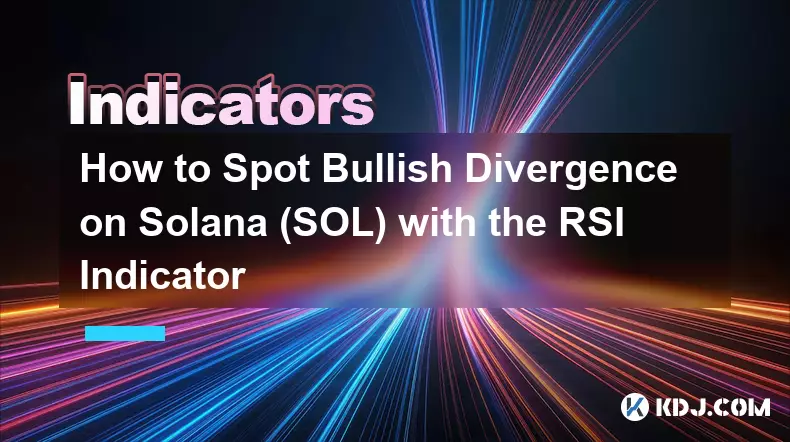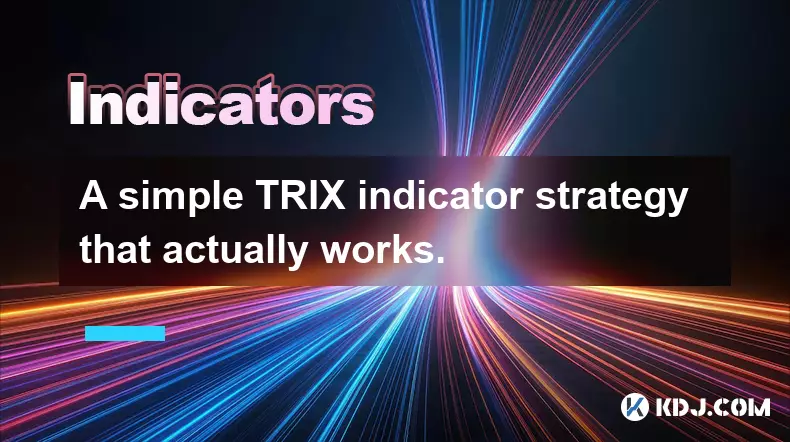-
 bitcoin
bitcoin $101752.865364 USD
-1.09% -
 ethereum
ethereum $3382.985899 USD
-1.38% -
 tether
tether $0.999658 USD
0.04% -
 xrp
xrp $2.272505 USD
-1.51% -
 bnb
bnb $989.089004 USD
0.14% -
 solana
solana $156.962612 USD
-3.08% -
 usd-coin
usd-coin $0.999776 USD
0.01% -
 tron
tron $0.290786 USD
-0.69% -
 dogecoin
dogecoin $0.174594 USD
-2.86% -
 cardano
cardano $0.560085 USD
-3.55% -
 hyperliquid
hyperliquid $40.023704 USD
-5.75% -
 chainlink
chainlink $15.324649 USD
-2.78% -
 bitcoin-cash
bitcoin-cash $493.576540 USD
-3.52% -
 zcash
zcash $571.320038 USD
-12.05% -
 stellar
stellar $0.280066 USD
-4.26%
How to Spot Bullish Divergence on Solana (SOL) with the RSI Indicator
Bullish divergence in Solana occurs when price makes lower lows but RSI forms higher lows, signaling weakening bearish momentum and a potential upward reversal.
Oct 31, 2025 at 05:54 pm

Understanding Bullish Divergence in the Context of Solana
1. Bullish divergence occurs when the price of an asset, such as Solana (SOL), makes a lower low while the Relative Strength Index (RSI) forms a higher low. This mismatch suggests weakening downward momentum and hints at a potential reversal to the upside. Traders monitor this pattern closely during downtrends as it may signal exhaustion among sellers.
2. The RSI is a momentum oscillator that measures the speed and change of price movements on a scale from 0 to 100. Typically, readings below 30 indicate oversold conditions, while values above 70 suggest overbought levels. In the case of Solana, which often experiences high volatility, RSI readings can swing rapidly, making divergence analysis particularly useful.
3. For bullish divergence to be valid on SOL, both price action and RSI must form clear, identifiable lows. A single candle or minor dip does not qualify. The formation should involve distinct swing points where the price breaks below a prior low but the RSI fails to do so, instead rising or holding above its previous low.
4. Confirmation is essential. Many traders wait for additional evidence such as a break above a recent resistance level or a bullish candlestick pattern like a hammer or engulfing bar before acting on the divergence signal. This reduces false positives, especially in choppy or sideways markets.
5. Timeframe selection plays a crucial role. While bullish divergence can appear on shorter timeframes like 15-minute or hourly charts, signals on daily or weekly frames carry more weight due to stronger institutional participation and reduced noise. Aligning multiple timeframes increases the reliability of the setup.
Steps to Identify Bullish Divergence Using RSI on SOL
1. Load the Solana price chart on your preferred trading platform and apply the RSI indicator with the default period of 14. Ensure the RSI panel is positioned directly beneath the price chart for easy visual comparison.
2. Locate two consecutive troughs in the price movement where the second low is lower than the first. These represent the bearish progression in the market. Simultaneously, observe the corresponding RSI values at these two points.
3. Compare the RSI lows. If the RSI at the second price low is higher than at the first, you have identified a bullish divergence. This indicates that despite the price decline, selling pressure is diminishing.
4. Draw trendlines connecting the RSI lows to visualize the divergence clearly. A rising RSI trendline under a falling price trendline strengthens the case for a reversal. Some platforms allow annotations, which help in marking these patterns for future reference.
5. Watch for volume confirmation. An increase in buying volume during the second low supports the idea that accumulation is taking place. Low volume during new price lows suggests lack of conviction among sellers, further validating the divergence.
Risks and Limitations of RSI-Based Divergence Signals
1. False signals are common, especially during strong trends. Solana can remain oversold or overbought for extended periods due to macroeconomic factors or network developments. A divergence pattern does not guarantee a reversal—it only suggests a potential shift in momentum.
2. Lagging nature of RSI means it reacts to price changes rather than predicting them. By the time divergence becomes visible, part of the move may already have occurred, reducing entry efficiency.
3. Market manipulation and whale activity on crypto exchanges can distort RSI readings. Large sell or buy walls may trigger artificial price swings that create misleading divergence patterns, particularly on lower-cap altcoins or even mid-tier assets like SOL during low-liquidity periods.
4. Overreliance on a single indicator is risky. Combining RSI divergence with support/resistance levels, moving averages, or on-chain metrics such as exchange outflows improves decision-making accuracy.
5. Short-term volatility in Solana’s ecosystem—driven by NFT launches, DeFi protocol incentives, or validator updates—can disrupt technical patterns. Traders must factor in fundamental catalysts alongside technical setups.
Frequently Asked Questions
What timeframe is best for spotting RSI bullish divergence on Solana? The daily chart offers the most reliable signals due to reduced noise and alignment with broader market cycles. However, active traders may use the 4-hour chart for earlier entries, provided they confirm with higher-timeframe trends.
Can bullish divergence occur during an uptrend? Yes, though it's less common. In an uptrend, bullish divergence might appear after a pullback, signaling continuation rather than reversal. It reflects temporary weakness being absorbed by buyers before the rally resumes.
How long does a typical bullish divergence last before a reversal happens? There is no fixed duration. Some reversals occur within days, while others take weeks. The key is patience and confirmation through price action, such as closing above a key moving average or breaking a descending trendline.
Does RSI divergence work equally well across all cryptocurrencies? No. Assets with consistent liquidity and trading volume, like Solana, tend to produce more reliable signals. Low-volume tokens often generate erratic RSI behavior, increasing the likelihood of false divergences.
Disclaimer:info@kdj.com
The information provided is not trading advice. kdj.com does not assume any responsibility for any investments made based on the information provided in this article. Cryptocurrencies are highly volatile and it is highly recommended that you invest with caution after thorough research!
If you believe that the content used on this website infringes your copyright, please contact us immediately (info@kdj.com) and we will delete it promptly.
- Ripple (XRP) in 2026: Hold or Fold? A Look at XRP's Future and Emerging DeFi Alternatives
- 2025-11-08 18:35:01
- Zcash ZEC Coin Price Explosion: From Privacy Niche to Center Stage
- 2025-11-08 18:55:01
- Berachain Price Prediction: Navigating the Honeycomb Hype in Crypto
- 2025-11-08 18:55:01
- Arthur Hayes, Gold, and Bitcoin: A Modern Monetary Trinity?
- 2025-11-08 19:15:01
- Shiba Inu's Next Move: Navigating a Shifting Market
- 2025-11-08 19:20:01
- Pakistan's Crypto Crossroads: Balancing Opportunity with Asset-Backed Realities
- 2025-11-08 19:20:01
Related knowledge

How do professional traders use the TRIX indicator?
Nov 06,2025 at 04:40pm
Understanding the TRIX Indicator in Crypto TradingThe TRIX (Triple Exponential Average) indicator is a momentum oscillator used by professional trader...

Can I use the TRIX indicator on my mobile trading app?
Nov 07,2025 at 07:40pm
The TRIX indicator, a momentum oscillator designed to filter out short-term fluctuations and highlight long-term trends, has become increasingly popul...

How to code a simple TRIX indicator script in Pine Script?
Nov 07,2025 at 06:20am
How to Code a Simple TRIX Indicator in Pine Script The TRIX (Triple Exponential Moving Average) indicator is widely used in cryptocurrency trading to ...

A simple TRIX indicator strategy that actually works.
Nov 08,2025 at 05:39pm
Understanding the TRIX Indicator in Crypto Trading1. The TRIX (Triple Exponential Average) indicator is a momentum oscillator designed to filter out s...

How to trade TRIX indicator signals on the 1-hour chart?
Nov 07,2025 at 05:39am
Bitcoin's Role in Decentralized Finance1. Bitcoin remains the cornerstone of decentralized finance, serving as a benchmark for value and security acro...

Can the TRIX indicator be used for long-term investing?
Nov 06,2025 at 02:19pm
Understanding the TRIX Indicator in Cryptocurrency Markets1. The TRIX (Triple Exponential Average) indicator is a momentum oscillator designed to filt...

How do professional traders use the TRIX indicator?
Nov 06,2025 at 04:40pm
Understanding the TRIX Indicator in Crypto TradingThe TRIX (Triple Exponential Average) indicator is a momentum oscillator used by professional trader...

Can I use the TRIX indicator on my mobile trading app?
Nov 07,2025 at 07:40pm
The TRIX indicator, a momentum oscillator designed to filter out short-term fluctuations and highlight long-term trends, has become increasingly popul...

How to code a simple TRIX indicator script in Pine Script?
Nov 07,2025 at 06:20am
How to Code a Simple TRIX Indicator in Pine Script The TRIX (Triple Exponential Moving Average) indicator is widely used in cryptocurrency trading to ...

A simple TRIX indicator strategy that actually works.
Nov 08,2025 at 05:39pm
Understanding the TRIX Indicator in Crypto Trading1. The TRIX (Triple Exponential Average) indicator is a momentum oscillator designed to filter out s...

How to trade TRIX indicator signals on the 1-hour chart?
Nov 07,2025 at 05:39am
Bitcoin's Role in Decentralized Finance1. Bitcoin remains the cornerstone of decentralized finance, serving as a benchmark for value and security acro...

Can the TRIX indicator be used for long-term investing?
Nov 06,2025 at 02:19pm
Understanding the TRIX Indicator in Cryptocurrency Markets1. The TRIX (Triple Exponential Average) indicator is a momentum oscillator designed to filt...
See all articles





















![The Graph Price Prediction [GRT Crypto Price News Today] The Graph Price Prediction [GRT Crypto Price News Today]](/uploads/2025/11/07/cryptocurrencies-news/videos/690d4df44fe69_image_500_375.webp)




















































